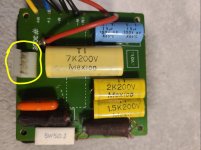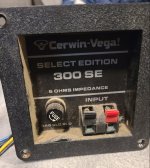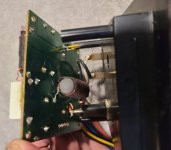Bought a set of Cerwin Vega 300 SE 12" 3 way speakers from Sears back in 87, and besides changing the woofer surrounds occasionally, they've been trouble free, until now. One mid range speaker has stopped working. The speaker itself is good as I swapped it in the other cabinet and it works. When I remove the crossover(and connect all the wires again) and check volts with an analog multimeter, I get needle movement(with music playing) on the mid range speaker wires in the good cabinet but not the bad one. I also unplugged the connector on the crossover board(circled in yellow) and did a resistance test on the wires going to the midrange potentiometer(?). I get a resistance change when I rotate the dial as if the mid speaker adjustment knob has conductivity and is working so that part is ruled out. But when I play music and volt test the pins on the connector on the board(circled in yellow) I don't get any needle movement so it has to be a component on the crossover board. Any suggestions on what to test on the board. I've read elsewhere that it's unlikely the big yellow mylar film capacitors are bad because they rarely go out but like everything else you read on the internet. Should I remove them one by one to test them or is there something else worth checking 1st? Thanks
Attachments
Welcome to the forum!
First let's get the obvious out of the way. Have you checked the fuse? It would appear to protect both the mid and the tweeter.
The component on that mid/tweeter crossover board most likely to fail is the blue 15 uF NP (non-polar or bipolar) electrolytic capacitor.
You could temporarily swap it with the one on the working speaker's crossover board to check if the fault follows the capacitor.
Other than that, check all the solder joints on the rear of the circuit board and resolder any that look dodgy.
Unfortunately, I can't locate a schematic showing the crossover and wiring arrangement of this speaker in order to aid diagnosis.
First let's get the obvious out of the way. Have you checked the fuse? It would appear to protect both the mid and the tweeter.
The component on that mid/tweeter crossover board most likely to fail is the blue 15 uF NP (non-polar or bipolar) electrolytic capacitor.
You could temporarily swap it with the one on the working speaker's crossover board to check if the fault follows the capacitor.
Other than that, check all the solder joints on the rear of the circuit board and resolder any that look dodgy.
Unfortunately, I can't locate a schematic showing the crossover and wiring arrangement of this speaker in order to aid diagnosis.
That blue cap you could probbly replace for a dollar or two.
If you have an analog voltmeter with a "needle" meter you might see a difference between the two caps in the different speakers in the way the needle jumps if you put the meter across the caps in resistance mode.
If you have an analog voltmeter with a "needle" meter you might see a difference between the two caps in the different speakers in the way the needle jumps if you put the meter across the caps in resistance mode.


